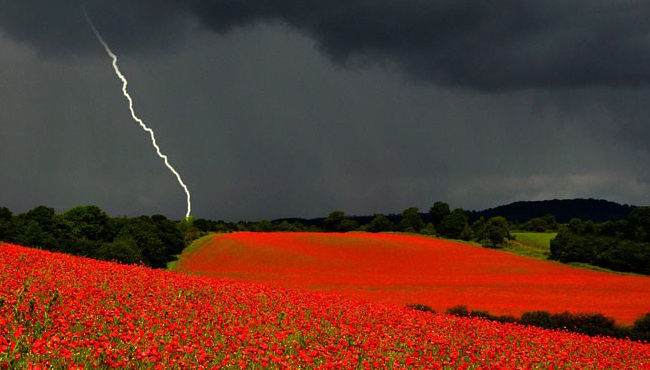Exhibition Turns Climate Data into Artistic Experience
- Published: February 5th, 2013
23 10 11 0

By
Michael D. Lemonick
Follow @MLemonick
The Compton-Goethals Art Gallery at The City College of New York is ordinarily devoted to the kind of exhibitions you might expect — photography shows, or displays of painting, or sculpture, or even something more contemporary, like a video installation.
But it’s clear from you moment you walk into the gallery that the show
on display through February 14 is something very different. The ice-climbing outfit hanging from the wall in one corner is probably the first clue, but then you notice a series of sciency-looking informational graphics on the far side of the room — and then a counter with headphones dangling from the ceiling off to the right. It’s true that one wall is covered with abstract-looking, large-format photographs, but on balance, it’s not entirely clear whether you’ve entered an art gallery or a science museum.
In fact, it’s a little of both. The title of the show — “Communicating Polar Climate Change Through Data Visualization And Sonification” — is admittedly a bit clunky, but the intent is elegant and the execution impressive. “We scientists don’t always communicate our work to the public very well,” said Marco Tedesco, a professor of earth and atmospheric sciences at City College, showing a visitor around a few days before the exhibition’s formal opening.
So Tedesco, a lifelong art aficionado, took advantage of a CCNY fund designed to foster interdisciplinary collaboration, reached out to colleagues in the college’s art and music departments, and spearheaded the development of a multimedia show that would try to reach the public in an unconventional way.
The focus is Greenland, Tedesco’s scientific specialty. That vast, frozen island holds enough ice to raise sea level by 20 feet if it were all to melt or slide into the sea. That won’t happen anytime soon, but there’s been enough melting in recent years —
especially last summer — to make experts like Tedesco worry about how much Greenland’s ice will add to seas already rising due to climate change.
These aerial images of the Greenland ice sheet, taken by Professor Marco Tedesco during his field research over the past several summers, convey the complexity and beauty of the ice, which is under assault by rising temperatures associated with human emissions of heat-trapping greenhouse gases.
Scientific explanations of why this is happening and what it means can often be dry and difficult to follow. The show itself, however, is anything but. Tedesco himself provided gorgeous, large-format photographs of the ice sheet as seen from helicopters — landscapes that show the almost infinitely varying texture, color and form of the ice, crisscrossed with cracks, and marked by patches of the black substance known as
cryoconite, a mixture of soot, dust (some of it from meteorites), and bacteria. He also provided
a video showing a huge lake of meltwater that formed atop the ice cap, then drained catastrophically when a crevasse opened. He even donated some of his ice-climbing gear, which hangs from the ceiling.
Those are the conventional parts of the show. It gets unconventional when you turn, for example, to a series of graphics that explain how the melting of Greenland is an
increasingly important factor in sea level rise; how the
movement of glaciers — not just the melting — helps send ice into the sea; and how the
reflectivity of the ice affects its melt rate. The graphics, designed by CCNY student
Vladimir Golosiy, rely not just on charts and diagrams, but on the vivid, creative use of typography.
One of the
several informational graphics featured at the exhibit.
Click to enlarge the image. Credit: Vladimir Golosiy.
“It’s all about the
Vitesse,” said Ina Saltz, director of the college’s Electronic Design & Multimedia Department and one of Tedesco’s collaborators, during a tour of the show, speaking about the unusually versatile typeface its designers call “Engineered for responsive handling and a sporty ride . . . confident and stylish in any situation.”
The concept of albedo — the relative brightness or darkness of ice — is also demonstrated vividly in a series of videos in which slabs of ice are artificially darkened and put under heat lamps next to untreated ice. Any physicist can tell you the darker ice will melt faster, as will Greenland’s natural ice when, say,
pollution in the form of soot falls on it. But the videos are far more striking than any verbal explanations.
That’s not all: there’s also
an interactive video game, in which players can vary the thickness of clouds to change the reflectivity of the atmosphere and see what that does to the ice below, and
a series of “sonifications” created by CCNY’s Jonathan Perl, an associate professor of music and audio technology.
These are transformations of hard scientific data about ice thickness, albedo and other factors into rich tapestries of sound that convey the changes to Greenland’s ice over recent decades. “This could be especially valuable for the visually impaired,” Tedesco said.
What you won’t see a whole lot of in this show is words, aside from some brief explanations of the science. But that’s the whole point. Scientists (and journalists) have poured out millions of words trying to convey the threat of climate change to the general public. It’s time to give artists a chance.






























